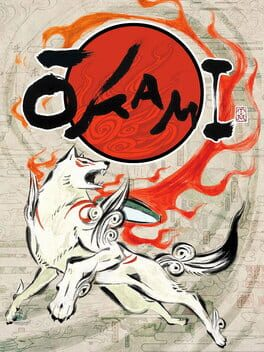▲
1
▼
In an interview, Hideki Kamiya admitted that early in the development, the team wanted to use the power slash move on the torii gates. However, the team removed the idea, as they all thought to themselves “should a goddess really be doing that?”
▲
1
▼
Once Orochi is defeated on the PlayStation 2 version, a crescent moon comes out in Shinshu Field. However, a full moon comes out in the Japanese version due to a programming mistake.
▲
1
▼
The name Okami actually has a dual meaning. When written as 狼 or オオカミ, it means "wolf". When written as 大神 (this writing is used in the game's logo), it means "great deity".
This is in reference to the protagonist Amaterasu, who is the Goddess of the Sun reincarnated as a wolf.
This is in reference to the protagonist Amaterasu, who is the Goddess of the Sun reincarnated as a wolf.
▲
1
▼
 The Clovers in the game are references to Clover Studio, the games developer, and when collected play a similar sound to their opening title.
The Clovers in the game are references to Clover Studio, the games developer, and when collected play a similar sound to their opening title.Since Clover Studio is now defunct, this may explained why the Clovers don't appear in Ōkamiden, but instead were replaced with Dandelions.
▲
1
▼
Okami's official soundtrack is 5 1/2 hours long. It has 215 tracks on 5 CD's.
▲
1
▼
When learning Cherry Bomb from Tama, he will show a fireworks display called "The Midnight Wonderboy", a reference to Alastor from Viewtiful Joe, as his chapter in that game is called "The Midnight Thunderboy."
▲
1
▼
After the Moon Cave in Sei'an City is a girl that's drawing. The drawing will be of whatever you had for a mask. She will also ask you to draw a few designs that she thinks will "be the next big hit." The second design she gives you is a V. When you come back to her, she describes it as the "henshin" pattern, which she finds "viewtiful" and exclaims "Henshin-a-go-go, Baby!". This is a clear nod to the Viewtiful Joe series. The third pattern she gives you is the clover pattern, which is a self reference to Clover Studios, the company who made the game. The last design she gives you is the kanji for heaven, which is also used by Akuma from Street Fighter on his Gi.
▲
1
▼
During the fight against Yamata no Orochi, the player can end the first phase of the fight in one blow by simply using an Exorcism Slip L on him while he is vulnerable. This trick only applies to the first Orochi fight; trying to perform the trick in the same way while battling Yamata no Orochi 100 years into the past will still leave him with a third of his health.
▲
1
▼
The first time you buy a technique from the Dojo, Onigiri Sensei will "transform" in a similar fashion to that of Viewtiful Joe.
▲
1
▼
During the cutscene before the first battle against Waka, he says "Let's Rock, Baby!" This is a reference to Dante's signature phrase in Devil May Cry. Both games were created by Hideki Kamiya.
In the French verison of the game, Waka's speech translates by "Let's Rock, Baby! As a famous devil hunter will say some day!"
Waka's laser-flute's name is also named "Pillow Talk", the name of the ranking theme in Devil May Cry.
In the French verison of the game, Waka's speech translates by "Let's Rock, Baby! As a famous devil hunter will say some day!"
Waka's laser-flute's name is also named "Pillow Talk", the name of the ranking theme in Devil May Cry.
▲
1
▼
When Mrs. Orange makes the cherry cakes that she promises you, she does a similar move to the Raging Demon that Akuma does in Street Fighter.
Related Games
Ōkamiden
Devil May Cry 3: Dante's Awakening
Gyakuten Saiban
Mega Man Xtreme 2
Street Fighter 2010: The Final Fight
Mega Man Battle Network 6: Cybeast Falzar
The 3rd Birthday
Mega Man X5
Red Dead Revolver
Mega Man Anniversary Collection
Street Fighter Alpha: Warriors' Dreams
Street Fighter II: Champion Edition
Ghost Trick: Phantom Detective
X-Men: Children of the Atom
Resident Evil
Mega Man X4
Dungeons & Dragons: Shadow over Mystara
God of War II
Silent Hill: The Short Message
Dino Crisis
Ultimate Marvel vs. Capcom 3
Mega Man 4
Onimusha 2: Samurai's Destiny
Resident Evil: The Darkside Chronicles
Warcraft III: Reign of Chaos
Marvel vs. Capcom: Infinite
Mega Man X6
Super Adventure Rockman
Resident Evil Outbreak File #2
Devil May Cry 4
Street Fighter Alpha 3
Ghosts 'n Goblins
Ultra Street Fighter II: The Final Challengers
The Great Ace Attorney 2: Resolve
Mega Man Network Transmission
Resident Evil 7: Biohazard
Mega Man: The Power Battle
Final Fight Guy
Destiny of an Emperor
Mega Man Anniversary Collection
Mega Man 10
SNK vs. Capcom: The Match of the Millennium
Strider
Mega Man 6
Mega Man Star Force: Leo
Glass Rose
We Love Golf!
Resident Evil 2
Onimusha: Dawn of Dreams
Mega Man Battle Network 3 White




